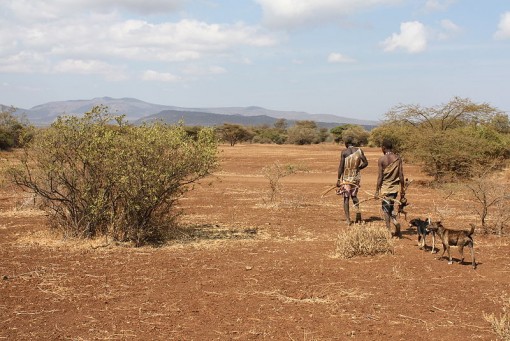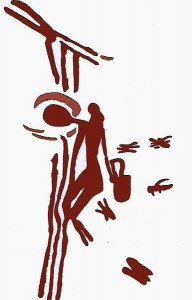 Quite by accident last week, I came across something, an ethnographic detail really, that captured my imagination, and that has clearly delighted and puzzled anthropologists and even contributed to a new theory of human evolution. The detail concerned the Hadza, 1000 or so modern hunter-gatherers who speak an ancient click language and who live in the woodlands around Lake Eyasi, Tanzania, not far from Olduvai Gorge.
Quite by accident last week, I came across something, an ethnographic detail really, that captured my imagination, and that has clearly delighted and puzzled anthropologists and even contributed to a new theory of human evolution. The detail concerned the Hadza, 1000 or so modern hunter-gatherers who speak an ancient click language and who live in the woodlands around Lake Eyasi, Tanzania, not far from Olduvai Gorge.
The Hadza, as I discovered, prize honey above all else in their diet. Hadza mothers wean their young on liquid honey, and during the wet season, particularly the months of February and April, Hadza families gorge for weeks on its sticky sweetness. The men possess an expert knowledge of bees and bee behavior, giving the honeys produced by different species different names. Those who forage for honey figure prominently in Hadza mythology.
And there is indeed something almost magical about the way that Hadza collect honey.
 While out hunting, the men listen for the call of a small, robin-size bird known as the greater honeyguide (Indicator indicator.) The bird dines almost entirely on beeswax and bee larvae, but it needs help to crack open hives. So the honeyguide calls to both honey badgers and Hadza hunters. When human hunters whistle back, the bird gradually leads the men by call-and-response song to the nearest colony.
While out hunting, the men listen for the call of a small, robin-size bird known as the greater honeyguide (Indicator indicator.) The bird dines almost entirely on beeswax and bee larvae, but it needs help to crack open hives. So the honeyguide calls to both honey badgers and Hadza hunters. When human hunters whistle back, the bird gradually leads the men by call-and-response song to the nearest colony.
The Hadzas’ favorite type of honey, ba’alako, comes from the hives of the Apis unicolor adansonii, an aggressive species that frequently builds near the top of tall baobab trees. To gather it, the men pound wooden pegs into the tree trunk and climb with burning brush in their hands to smoke out the bees—a dangerous undertaking. One slip can lead to death. When the smoke has finally sedated the bees, the men steal the honey combs and reward the honeyguide with large chunks of beeswax.
Why is honey so crucial to the Hadza? In a recent paper, Alyssa Crittenden, an anthropologist and behavioral ecologist, at the University of Nevada, points out that wild honey is one of nature’s most energy-rich foods. It is 80 to 95 percent sugar and, if left unprocessed, contains both protein and fat from bits of bee larvae. As a rule, hunter-gatherers struggle to find calories: a scoop of honey supplies a huge hit.
 In her ethnographic research on honey consumption, Crittenden discovered that human hunters have long targeted bee hives. The artists who painted Altamira cave in what is now Spain some 25,000 years ago, for example, left depictions of bees, honeycombs, and—most amazing of all, in my opinion—honey collection ladders. And in Zimbabwe, archaeologists recorded a cave depiction of a human smoking out a beehive. San hunters and gatherers in the region told archaeologists that their ancestors had frequented the cave for nearly 10,000 years.
In her ethnographic research on honey consumption, Crittenden discovered that human hunters have long targeted bee hives. The artists who painted Altamira cave in what is now Spain some 25,000 years ago, for example, left depictions of bees, honeycombs, and—most amazing of all, in my opinion—honey collection ladders. And in Zimbabwe, archaeologists recorded a cave depiction of a human smoking out a beehive. San hunters and gatherers in the region told archaeologists that their ancestors had frequented the cave for nearly 10,000 years.
Last year, Crittenden proposed an intriguing new interpretation for the world’s earliest known stone tools—sharp flakes found in an excavation in Ethiopia and dated to some 2.5 million years ago. Crittenden thinks such stone tools could have been knapped by ancient honey collectors who needed sharp, strong implements to split open beehives. Armed with such tools, she suggests, our hominin ancestors may have dined extensively for the first time on energy-rich honey, a food that may have fueled the evolution of our large, metabolically costly brains. The earliest member of our genus, Homo, emerged some 1.5 to 2 million years ago, equipped with brains significantly larger than their predecessors. Moreover, they possessed smaller molars, suggesting that they were dining on an easily consumed food. Honey.
Did humans evolve from an insatiable desire for calories? Well worth thinking about, I’d say.
Photos: Hadza hunters, Andreas Lederer; Greater honeyguide, Jerry Oldenettel; Drawing of a painting from Cueva de la Arana, Utilasateur: Achillea
Oh, Heather, this is delightful! I will have an extra scoop of honey today, and give a little whistle of thanks.
Yes, just think of it as fuelling all those neurons needed to write! Thanks, Cameron!
Interesting. We are a species of thieves.
Man the thief; our taste for meat and fat came from kills stolen from other predators, our taste for bulk carbohydrates came from caches of roots, seeds and nuts stolen from hoarding rodents.
Otherwise we might still be eating bulk leafs and shoots and pithy fruits like the monkeys.
Hadza honey would contain probiotics as well as protein and fat; and it is eaten in an intermittent-fasting, and often calorie restricted setting. The men eat substantially more of the honey than the women.
“San hunters and gatherers in the region told archaeologists that their ancestors had frequented the cave for nearly 10,000 years.”
Excuse me, but they would have no way of knowing that 10,000 years had passed.
It is much more likely that the San were told this date by earlier archeologists.
Honey badger doesn’t care…
On a related note, amazing Youtube video of jungle tribesman climbing tree to get to a beehive:
http://www.youtube.com/watch?v=3W_iMve4xvg
Proterozoic: Thanks so much for the link to the Youtube video of a tribesman climbing for honey. It’s an amazing clip. I particularly loved the man’s line: “To climb a big tree, you have to empty your heart of fear.”
Sugar is good for the human body, It promotes an oxidative metabolism. People have been demonising sugar for a long time with no real valid research or evidence to back it up.